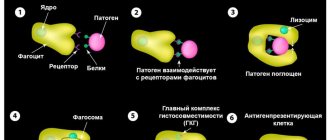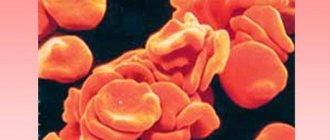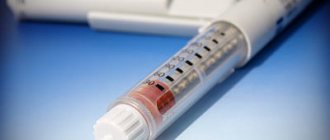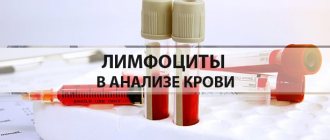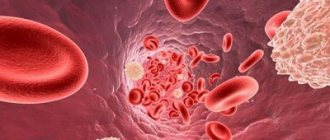Of course, blood tests play a significant role in diagnosing diseases. Knowing the participation of different types of leukocytes in the life of the body allows us to timely identify abnormalities and suspect pathology.
Band neutrophils are part of a large group of granulocytes and are precursors or younger (they are also called “young”) cells of the segmented type. They differ from their successors by having an undivided core of an oblong or twisted structure.
Doctors call them “sticks”, and if they are angry, “sticks”. Doctors of all specialties are familiar with the indicator.
Methods for counting quantities
Band neutrophils, like all blood cells, are counted in the finished smear after staining. They react to both acidic and alkaline reactions of paints. That's why they are called neutrophils.
A total count of cells of each type contained in a unit volume is carried out. For “rods” the absolute amount is normal from 1.8 to 6.5 x 109/liter of blood.
A more important indicator is the percentage of band forms in the total number of leukocytes. A detailed calculation of all types is the leukocyte formula.
On the right are the final cells: all with “freckles”, which means “granulocytes”, in the middle row the penultimate one is a band neutrophil
Functions and types of cells
Neutrophils are a type of leukocyte - white blood cells that are vital to the immune system. These cells are heterogeneous; in total there are 4 types of neutrophils, which differ in their narrow purpose:
- myelocytes are preneutrophils, maximally immature cells without differentiation, which can eventually turn not only into a neutrophil, but into any blood element: from a platelet to an eosinophil;
- young neutrophils are an immature version of neutrophils, a conditional reserve of cells that begin to work in conditions of the body’s increased need for immune cells; in critical situations, a minimum number of such cells can be recorded in the bloodstream (no more than 1%);
- band neutrophils - make up no more than 5% of the total number of neutrophils, this is already a partially specialized cell of the immune system, it works in the bloodstream if the remaining neutrophils cannot cope with their functions;
- segmented neutrophils are the basis of neutrophil cells; up to 70% of the total number of structures constantly work in the bloodstream; they manifest themselves to the maximum during the infectious and inflammatory process in the body.
Thus, there are only two types of active, that is, capable of acting, neutrophils: segmented and band. They solve the main tasks that the body sets for neutrophils:
- lyse the cell membrane of the pathogen, killing viruses, bacteria, fungi, and other pathogenic microflora;
- enter into an antigen-antibody reaction with microbes, binding pathogenic flora, accelerating the relief of inflammation;
- absorb microbes and digest them (phagocytosis): one cell can destroy up to 30 “strangers”;
- inactivate viruses, reducing the rate of replication of pathogens, helping to stop inflammation of a viral nature.
Norms
The norm of young neutrophils differs only in the first two weeks after the birth of children. The newborn gets rid of the mother's blood cells and begins to produce their own. During this period, there is a violation of the ratio between band and segmented neutrophils: the level of “segments” is 50–70%, and “rods” is from 3 to 12%.
Such a “distortion” quickly normalizes and throughout the rest of the child’s life and in adulthood it will be in normal conditions from 1 to 6%.
The level does not depend on the age of the adult; it is the same in men and women.
Interpretation of a general blood test
Below are the most basic indicators of the KBC, their functions in the body, and the reasons for deviations upward or downward.
Red blood cells
These are small elastic cells containing hemoglobin in their cytoplasm. Due to their elasticity, they easily pass through vessels of any caliber. They are produced in the bone marrow, the viability of one cell is about 3-4 months.
Red blood cells perform the following function: they carry oxygen from the lungs to all human tissues and organs, and on the way back from the tissues to the lungs they bring carbon dioxide. All this happens by adding gases to the hemoglobin of the red blood cell.
The norm of red blood cells when deciphering tests is on average from 3.8 to 5.0 1012/l
- An increase in red blood cells in a general blood test is possible with dehydration due to vomiting and diarrhea, diseases of the blood system (erythremia, Vaquez disease), cardiac and respiratory failure.
- their reduction can occur with blood loss, leukemia and lymphomas, congenital hematopoietic defects, hemolytic anemia, oncology, insufficient intake of protein, iron and vitamins.
It should be remembered that the norm of red blood cells, as well as other indicators, may differ in different laboratories. In which, moreover, errors are not excluded. Therefore, a borderline result does not always indicate a serious illness.
Hemoglobin
Hemoglobin is an iron-containing protein found in red blood cells. It is due to this that the function of gas exchange between the lung tissue and all cells of the body is performed. A deviation in hemoglobin levels from the norm can cause a person to feel unwell, weak, and easily fatigued. This is due to a lack of oxygen in organs, including the brain.
The normal hemoglobin content in a general blood test is on average 120-160 g/l, depending on the gender and age of the subject.
- An increase in hemoglobin can occur due to dehydration due to diabetes mellitus, vomiting and diarrhea, due to heart failure, overdose of diuretics, pulmonary failure, heart defects, diseases of the blood and urinary system.
- A decrease in hemoglobin in a general blood test is possible with anemia of various origins and other blood diseases, blood loss, insufficient intake of protein, vitamins, and iron
Leukocytes
These are white blood cells synthesized in the bone marrow. They perform the most important defense function in the body, aimed at foreign objects, infections, and foreign protein molecules. They are also able to dissolve damaged body tissue, which is one of the stages of inflammation. The viability of these cells varies from several hours to several years.
The norm of leukocytes in a general blood test corresponds to 4.0-9.0 109/l.
- An increase in leukocytes in the CBC is possible due to physiological errors (pregnancy, donating blood after meals, heavy physical activity, after vaccinations), inflammatory processes of a systemic or local nature, extensive injuries and burns, active autoimmune diseases, in the postoperative period, with oncology, leukemias and leukemias.
- If, when reading a blood test, leukocytes are reduced, the presence of viral infections, systemic autoimmune diseases, leukemia, radiation sickness, and hypovitaminosis is acceptable. Taking cytostatics and steroids may also affect this.
Color index
The color index (CI) is determined by a calculation method using a special formula. It shows the average concentration of hemoglobin protein (Hb) in one red blood cell.
Normally, the CPU is 0.8-1.0, without units of measurement.
- Its increase may indicate the presence of hyperchromic anemia (vitamin D deficiency).
- A decrease is possible in iron deficiency anemia, posthemorrhagic anemia, leukemia and lymphoma, and chronic organ diseases.
Hematocrit
This is an indicator reflecting the ratio of blood cells (leukocytes, erythrocytes, platelets) to the total blood volume. The analysis is carried out by centrifugation or using analyzers.
Normally, the hematocrit is on average 35-50%.
- An increase may indicate erythremia, respiratory failure, heart failure, dehydration due to diabetes mellitus and diabetes insipidus, diarrhea and vomiting.
- A decrease in hematocrit may be due to anemia, erythrocytopenia, renal failure, pregnancy (third trimester).
Reticulocytes
These are the precursors of red blood cells, their intermediate form. They perform the function of gas exchange, just like red blood cells, but with less efficiency. In a healthy person, reticulocytes, when deciphered, make up 0.2-1.2% of the total number of red blood cells.
- They may be increased during post-hemorrhagic restoration of hematopoiesis, when moving to a mountainous area or when treating anemia.
- Reticulocytes in the general blood test decrease with reticulocytopenia (slow hematopoiesis in the bone marrow, leading to anemia).
Platelets
These are small, flat blood cells that have no color. They perform several important functions - they participate in blood clotting, form platelet thrombus, regulate the tone of the vascular wall, and nourish capillaries.
In a general blood test, the normal platelet count is 180-320 109/l.
- An increase in platelets when deciphering the analysis is possible during splenectomy (removal of the spleen), exacerbation of chronic autoimmune diseases, anemia of various origins, inflammatory processes, in the postoperative period, the third trimester of pregnancy, in oncology, erythremia.
- Platelets in the CBC decrease in hemophilia, drug-induced thrombocytopenia, systemic lupus erythematosus, viral and bacterial infections, aplastic anemia, Evans syndrome, autoimmune thrombocytopenic purpura, and renal vein thrombosis.
ESR
Erythrocyte sedimentation rate (ESR) is an indicator calculated during a laboratory test. Under the influence of anticoagulants, the erythrocyte sedimentation time is calculated, which depends on the protein composition of the plasma.
This is a highly sensitive indicator; normally it averages from 1 to 15 mm per hour.
- It increases during physiological conditions (pregnancy, menstruation), during infectious diseases, malignant neoplasms, systemic autoimmune diseases, kidney diseases, in the postoperative period, during injuries and burns.
- Decreased in astheno-neurotic syndrome, recovery from infection, cachexia, long-term use of glucocorticoids, blood clotting disorders, high concentrations of glucose in the blood, traumatic brain injury, use of NSAIDs, immunosuppressants, antibiotics.
Neutrophils
This is the largest subtype of leukocytes, which, depending on the maturity of the cells, is divided into the following groups - young neutrophils, band neutrophils and segmented neutrophils.
They perform an antimicrobial function, are capable of phagocytosis, and participate in the inflammatory response.
The normal range of neutrophils in a blood test is band 1-6%, segmented 47-67%.
- An increase in neutrophils when decoding a blood test is possible under physiological conditions (sun and temperature exposure, stress, pain, etc.), previous infections, bone marrow diseases, oncology, taking certain medications, ketoacidosis, poisoning with poisons and alcohol, and parasitosis , allergies, hyperglycemia.
- They decrease in the state after chemotherapy, with HIV/AIDS, aplastic anemia, long-term infectious disease, exposure to radiation, deficiency of vitamin B12 and folic acid.
Lymphocytes
This is also a subtype of leukocytes, presented in the form of T lymphocytes, B lymphocytes, K and NK lymphocytes.
All of them participate in acquired immunity, synthesize antibodies, destroy not only foreign, but also their own pathological cells (oncological).
The norm of lymphocytes when deciphered in the CBC is 18-40%
- An increase in the general blood test can occur with viral infections (mononucleosis, viral hepatitis and others), toxoplamosis, blood diseases (chronic and acute lymphocytic leukemia, lymphoma, leukemia), with arsenic, lead poisoning, taking levodopa, narcotic painkillers.
- Lymphocytes decrease in tuberculosis, HIV, blood diseases (lymphogranulomatosis, aplastic anemia), end-stage renal failure, cancer in the terminal stage and during treatment with radiotherapy and chemotherapy, taking glucocorticoids.
Monocytes
This is a type of the largest leukocytes, also synthesized in the bone marrow. They are able to phagocytose (absorb) viruses, bacteria, tumor and parasitic cells. Regulate hematopoietic function and participate in blood clotting.
The normal blood test for monocyte content is 3-11%.
- an increase in monocytes when deciphered indicates viral, bacterial (tuberculosis, syphilis, brucellosis), fungal and parasitic infections, inflammation in the regeneration stage, systemic autoimmune diseases (systemic lupus erythematosus, rheumatoid arthritis), leukemia.
- a decrease in monocytes in a blood test is possible during purulent-inflammatory processes, aplastic anemia, in the postoperative or postpartum period, and when taking steroids.
Quantity changes
The change in the number of band neutrophils depends on the general fluctuations of leukocytes and granulocytes. All five varieties are connected by the function of providing immunity and protecting the body from harmful influences.
The need for an increased level of protective reaction and the beginning of the fight against infectious agents causes an adequate response, accompanied by an increase in the production of “rods” and their maturation into segmented finished cells. The “segments” die after a few days, and new cells take their place from the rod forms.
The general decrease in neutrophils is also reflected in the reduction of “rods” until they completely disappear in the blood. Neutropenia (low) neutrophil levels or an increase in neutrophilia always affects progenitor cells.
How are they indicated in the analysis?
The relative abundance of neutrophils is indicated in a line beginning with the character set NEUT% (NE%) (neutrophils). The designation for the absolute content of neutrophils in a blood test looks somewhat different. The form contains a ciphergram in which the % sign is replaced by #: NEUT# (NE#) (neutrophils).
Form with blood test results
When band neutrophils are absent
The main causes of neutropenia are associated with suppression (excess) of the production of leukocyte cells. This occurs in severe pathology:
- bacterial infections (typhoid and paratyphoid fever, chronic brucellosis, tularemia);
- viral infection leading to the predominant synthesis of monocytes and lymphocytes and suppression of neutrophils (rubella, diphtheria, scarlet fever, influenza, measles in children, viral hepatitis);
- toxic effect of medications on the processes of blood cell synthesis (sulfonamides, analgesics, interferon, immunosuppressive drugs);
- aplastic anemia and associated with deficiency of folic acid and vitamin B12;
- the effects of radiation, radiation and chemotherapy for tumors, leukemia.
In all cases, a decrease in the number of neutrophils and the absence of their band forms indicates suppression of the immune system and a general weakening of the body.
If absent in the blood
A number of diseases and factors lead to a quantitative decrease in immature defender cells. For example:
- viral diseases (measles, rubella, etc.);
- mycoses;
- anemia;
- chemical poisoning;
- oncological processes and consequences of radiation;
- hyperthyroidism;
- taking certain medications.
The absence of band neutrophils in the blood of an adult does not always mean that he is sick or is under the influence of factors leading to neutropenia.
In most cases, 0 in an adult is a laboratory error. 1 percent in an adult is an indicator of health.
Why do band neutrophils increase?
Against the background of common reasons for an increase in the level of segmented neutrophils in bacterial and fungal diseases (rheumatism, infectious arthritis, genitourinary inflammatory diseases), severe intoxications, and blood diseases, special attention is paid to the role of “rods” in diagnosis.
Physical activity, pregnancy and labor can cause a temporary increase in neutrophils, but the level of band forms remains within normal limits.
Band neutrophils are increased when:
- septic conditions;
- severe tonsillitis;
- purulent diseases of the skin and subcutaneous tissue (abscesses, phlegmon);
- hematopoietic diseases.
An increase in the level above 6% is called a shift of the formula to the left (towards younger forms).
With such purulent plugs on the tonsils, the number of “sticks” increases significantly
When is the test prescribed?
A clinical blood test with a leukocyte formula is indicated for patients with various pathologies. It allows you to assess a person’s health status with a comprehensive and timely diagnosis of diseases, including those occurring in a latent form.
Indications for a clinical blood test with a leukocyte formula are:
- medical examination or routine medical examination;
- preparation for surgical treatment;
- infection or suspected infection;
- suspicion of inflammation or parasitic infestation in the patient’s body;
- allergic reactions;
- prescribing certain medications;
- monitoring the effectiveness of treatment.
Before donating capillary blood, it is recommended not to drink alcohol during the day, not to eat for 2-3 hours, not to smoke for 30 minutes and to avoid stress and excessive physical activity.
Leukocyte formula:
| Index | × 10x9/l | ratio, % | |
| Neutrophils | segmented | 2,1–5,4 | 43–71 |
| stab | 0,4–0,3 | 1–5 | |
| Basophils | up to 0.063 | up to 1 | |
| Eosinophils | 0,02–0,3 | 0,5–5 | |
| Lymphocytes | 1,1–3,1 | 17–38 | |
| Monocytes | 0,08–0,5 | 3–12 | |
